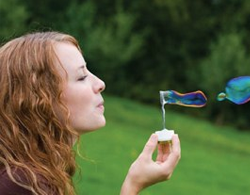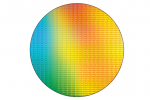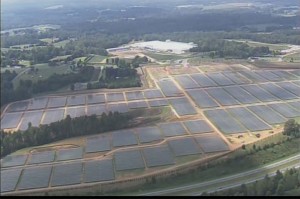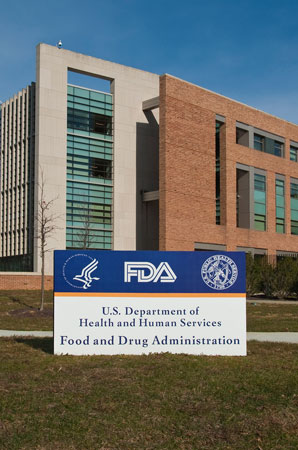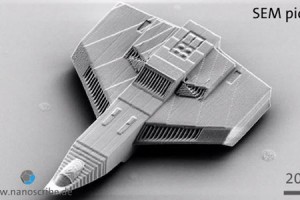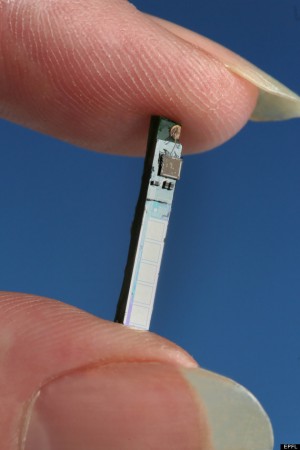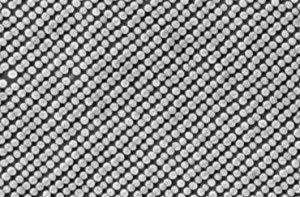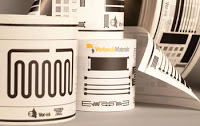Nanooze Blog
Important news for coffee drinkers
Scientists have determined that it is harder to spill a latte than just a regular cup of coffee. The first question is—-wow scientists have a lot of time on their hands. OK forget about the first question. The real question is why? The layers of bubbles on a latte (from the foam, the steamed milk) prevent the coffee from sloshing around. The original observation came from a researcher recalling that Guinness didn’t slosh around as much as other beers (this is the answer to question #1). They did experiments using detergent to form different thicknesses of foam and observed that the foam dissipated the energy from the liquid when it was rocked back and forth. There is even a scientific publication on the subject:
- A. Sauret, F. Boulogne, J. Cappello, E. Dressaire and H. A. Stone. Damping of liquid sloshing by foams. Physics of Fluids, February 24, 2015 DOI: 10.1063/1.4907048
the next generation of chips
Moore’s Law named for Gordon Moore the founder of Intel describes the idea that the size of transistors will continue to decrease so that we can put more of them into a single chip. Back in the 1970s, there were about 2,000 transistors in your average ‘chip’. Today there are well over 2,000,000,000. The newest transistors, called the Broadwell are only 14 nanometers in size. Remember that a nanometer is 1/1,000,000,000 of a meter so if you took 71,000,000 of these transistors and laid them end to end it would be about a meter. Scientists believe that Moore’s law (that demands at least two-fold improvements less than every two years) will be valid up to the 7 nanometer scale. Then what? Scientists are working hard on different kinds of transistors that will be made of single molecules from which we can make even smaller transistors.
Glucose sensing tattoo
Scientists from the University of California-San Diego have developed a tattoo that can monitor your glucose levels. 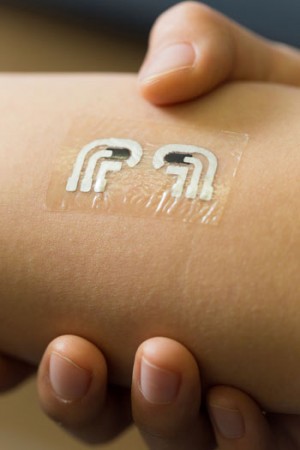 Monitoring glucose is important for maintaining health in individuals with diabetes. The flexible tattoo is able to measure the glucose levels through the skin using an enzyme reaction that generates a tiny current. It is non-invasive so you don’t have to prick your skin and draw a drop of blood. The researcher provide some proof of concept by comparing their tattoo to standard glucose monitoring.
Monitoring glucose is important for maintaining health in individuals with diabetes. The flexible tattoo is able to measure the glucose levels through the skin using an enzyme reaction that generates a tiny current. It is non-invasive so you don’t have to prick your skin and draw a drop of blood. The researcher provide some proof of concept by comparing their tattoo to standard glucose monitoring.
Apple solar panels
There are lots of solar panel systems being installed to take advantage of advances in the conversion of sunlight to electricity. In the next issue of Nanooze we write about how nanotechnology is making solar power more efficient—the more efficiently we can covert light into electricity the less panels you need to power a home, a car, anything.
Apple is building a space-age building and to power it they are installing a 1300 acre solar farm in California. Apple is investing close to a $1B in the project. The amount of power that will be produced is enough to p
over 50,000 homes. This new installation goes along with a few others including the solar farm in North Carolina which is used to power their data center.
FDA issues rules on nano
Nanotechnology can offer lots of solutions to many of today’s challenges. In the world of medicine, the Food and Drug Administration is responsible for regulating medicine and medical devices in the US. The FDA has recently adopted three standards for things like particle size distribution, and how to characterize the surface of gold nanoparticles. Mostly the worry is about unbound nanoparticles, and how they might affect your health.
Blacker than Black?
Color…… What do we mean when we say an object is “red”, or “blue” or “black”.
We see an object’s color as the color of light that it reflects. A red shirt is red because it reflects (bounces back) red light (and absorbs all other colors). And blue pants are blue because they reflect blue light (and absorb all other colors). And if an object reflects ALL light, we call it white. And if an object does not reflect any light, we call it black. Black objects absorb all the light that falls on them. Black is the ultimate dark color.
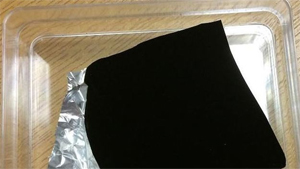 But can anything be truly black, that is, absorb all light of all colors. And the answer is no, even the blackest black reflects just a little bit of light. In really, everything we see as black is just some really really really dark shade of grey!
But can anything be truly black, that is, absorb all light of all colors. And the answer is no, even the blackest black reflects just a little bit of light. In really, everything we see as black is just some really really really dark shade of grey!
But, using nanotechnology, scientists in England have succeeded in making the blackest material ever. They call it “Vantablack”, and it absorbs 99.96% of all light that falls on it. This ultra-black material is formed by coating the surface with nanotubes. Nanotubes are tiny tubes of carbon atoms; Vantablack material consists of a dense forest of carbon nanotubes. Light gets trapped between all the nanotubes and is ultimately absorbed, with very very little reflection. The result is a surface that is weirdly black, very black. And because we sense texture and shape by reflected light, it is a surface that looks very very flat even when it isn’t.
So what is it good for? It would be a lot of trouble to go through just to have car that was blacker than everyone else’s. But scattered light really is a problem in various scientific instruments, for example, in telescopes. Using Vantablack to coat sensitive optical instruments can greatly improve their sensitivity.
Who would have thought that there was something to invent about “black”.
If a Little Filter Is Good, then Shouldn’t a BIG One Be Even Better?
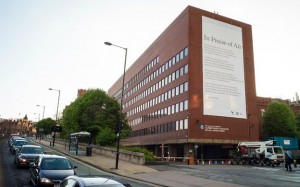 Even little children know that bigger is better. ( I think there is a cell phone commercial that continuously reminds us of that.!) And when you are talking about filtering out air pollution, you really do need BIG.
Even little children know that bigger is better. ( I think there is a cell phone commercial that continuously reminds us of that.!) And when you are talking about filtering out air pollution, you really do need BIG.
Scientists have known that nanoparticles of Titanium Dioxide can fiter out pollutants from air–pollutants like nitrogen oxides that come from car exhausts, for example. Titanium Dioxide is the stuff that makes white paint white, and if you make the particles small enough they react with pollutants and remove the noxious gases from the air. So why not use paint as a filter! And as long as you are painting, why not paint a whole building !!
Scientists at the University of Sheffield in England have just done that! They turned the side of a building into a giant nanotechnology pollution eating poster, 10 meters x 20 meters ( that is about 30 ft x 60 ft). When light hits the poster, it excites the nanoparticles and makes then more reactive to the pollutants, removing them from the air. (That is a recurring theme in nanotechnology—nanoparticles can be more chemically reactive and can interact with light differently than larger particles of the same material.)
Just think how much pollution could be removed if lots of buildings were covered with “nano-painted posters”!
Splitting water
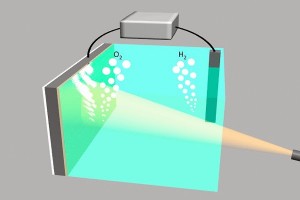
This image shows two electrodes connected via an external voltage source splitting water into oxygen (O2) and hydrogen (H2). The illuminated silicon electrode (left) uses light energy to assist in the water-splitting process and is protected from the surrounding electrolyte by a 2-nm film of nickel.
You can spit water but you can also split water. The splitting of water is important because when you split H2O you get two molecules of hydrogen and one molecule of oxygen. Both are important and hydrogen can be used as a fuel. Unlike solar cells they don’t require sunshine and can be used in places not considered to be sunny enough to efficiently generate energy from solar cells. There have been lots of fuel cells based upon splitting up water and you can even reverse the process to generate clean water from hydrogen and oxygen. The group at Stanford University have used silicon a material also used in solar cells. They coated the electrodes with nickel to help improve the process and lower the cost.
Another Blood Sucker
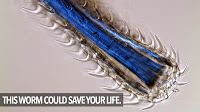 Tape, glue, staples. No not a variation on rock, paper, scissors, this is the way that doctors hold things in place in your body. Inspired by those fun loving parasites that attach in your digestive organs and hold on while they eat, scientists at Brigham Women’s Hospital have engineered tiny needles based upon the way that parasites attach to the intestines. The needles swell when they are exposed to water and then hold on. This approach is 3-5 times better than surgical tape and could be used to attach patches that deliver different medicines. Ouch, it might hurt to remove it though.
Tape, glue, staples. No not a variation on rock, paper, scissors, this is the way that doctors hold things in place in your body. Inspired by those fun loving parasites that attach in your digestive organs and hold on while they eat, scientists at Brigham Women’s Hospital have engineered tiny needles based upon the way that parasites attach to the intestines. The needles swell when they are exposed to water and then hold on. This approach is 3-5 times better than surgical tape and could be used to attach patches that deliver different medicines. Ouch, it might hurt to remove it though.
Suck It Up
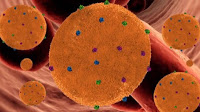 Sometimes it is rocket science and other times it isn’t. How to get rid of toxic stuff in the blood? Suck it up using nanosponges. Scientists at the University of California in San Diego have made tiny sponges—so small about 3000 can fit into a blood cell. These nanosponges suck up molecules that are toxic because they form pores membranes. Bacteria like E. coli and Staphylococcus produce these toxin and disease like toxic shock syndrome. A bit too soon to get a nanosponge treatment but the idea is exciting.
Sometimes it is rocket science and other times it isn’t. How to get rid of toxic stuff in the blood? Suck it up using nanosponges. Scientists at the University of California in San Diego have made tiny sponges—so small about 3000 can fit into a blood cell. These nanosponges suck up molecules that are toxic because they form pores membranes. Bacteria like E. coli and Staphylococcus produce these toxin and disease like toxic shock syndrome. A bit too soon to get a nanosponge treatment but the idea is exciting.
Read more or for all the details here
Does It Come In Different Colors?
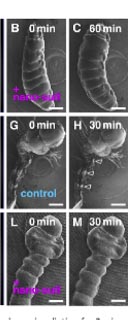 Science even when it is serious is kind of funny. Looking at things on the nanometer-scale is a problem and requires very powerful microscopes. Some of these microscopes that use electrons instead of light are able to see very small things but also usually kill anything that it ‘sees’. Basically the electron beam dries out the cells and leaves those critters dead. Scientists at the Japan Science and Technology Agency have devised a clever solution—coat the living thing that you want to see in a polymer suit. These nanosuits are made of a polymer and some detergent but it is flexible and protects the critter while it is being zapped with electrons. Because the nanosuit is polymerized right on the critter, it is a nice custom fit. Oh and does it come in colors? of course not because at the nanometer-scale there is no color.
Science even when it is serious is kind of funny. Looking at things on the nanometer-scale is a problem and requires very powerful microscopes. Some of these microscopes that use electrons instead of light are able to see very small things but also usually kill anything that it ‘sees’. Basically the electron beam dries out the cells and leaves those critters dead. Scientists at the Japan Science and Technology Agency have devised a clever solution—coat the living thing that you want to see in a polymer suit. These nanosuits are made of a polymer and some detergent but it is flexible and protects the critter while it is being zapped with electrons. Because the nanosuit is polymerized right on the critter, it is a nice custom fit. Oh and does it come in colors? of course not because at the nanometer-scale there is no color.
Lighter Than a Butterfly
Nanotechnology is all about making unique useful materials. Now the worlds lightest material has been recorded. According to these scientists the material a carbon aerogel, if it were the size of a human body it would be less than 0.5 ounces. So light a glob of it can dance on the tip of a flower! Being lightweight isn’t always great but it is if the material is strong and durable. This carbon aerogel stuff can also absorb 900 times its weight in liquid. How is it made? The process is more or less the freeze drying of carbon nanotubes and graphene
For Flying Fleas to Far off Galaxies
Smaller is better, if you are a nanotechnologist. So the challenge is to make things smaller and smaller. Sometimes it is useful, other times it is for fun. Like the smallest American flag, or the smallest space ship! Right a space ship. One printed using a high resolution 3D printer. Scientists at the University of Austria have used a 3D printer to make a tiny space ship (and a tiny race car) using a lithographic printing technique that builds things up on a layer by layer basis. The space ship was about 100,000 nanometers or about the width of a hair. It took only 50 seconds to make. Does it fly? Not on its own but it is still cool to see.
Check out the video
Little Blood Sucker
Usually if you need to have your blood tested it means going to a doctor’s office having some blood drawn and then waiting a while—the blood is sent to a central laboratory and then the results come back in a few days or so. But imagine if you had a gizmo that was inserted under your skin and tested your blood sending out the results wirelessly. ‘too much cholesterol, not enough vitamin B!’ and then you could eat right or exercise more. Scientists at the EPFL (École polytechnique fédérale de Lausanne–a great research institution in Switzerland) have developed a tiny device to do just that. The sensor is very small and it receives its power from another part of the device that is outside of your skin (think how a cordless toothbrush is charged). The results are then sent by Bluetooth to a doctors computer where the results can be interpreted.
Smaller and Smaller
What is the smallest thing you can think of? an electron, a quark? Well now what is the smallest thing you can make? The answer is complicated but one thing you can say is that the smallest piece of a hard drive is about 10 nanometers. That is 10-one billionth of a meter. If you take your average hair and slice it along its width 10,000 times you get 10 nanometers. How about the other way of thinking about it….you need only 50 atoms to make something that is 10 nanometers. Engineers at HGST, a part of Western Digital (you might even have one of their hard drives in your computer) have made 10 nanometer magnetic islands which can be used for data storage. Why is this important? It means you can pack much more data in the same size drive. To make these 10 nanometer magnetic islands, the HGST engineers used ‘self-assembling’ molecules and nanoimprinting techniques.
read more
Lab on a Stamp
Lab on a chip, how common. How about lab on a stamp. Scientists at Harvard are experimenting with paper as a material for making tiny sensors. Paper is cheap and it turns out it can do a lot of things like separating different molecules. You’ve probably done some experiments looking at the way colors separate using paper like the one used to make coffee filters. Now add in some inks that are hydrophobic and can be used to direct liquids to different parts of the paper sensor and you are going a long way to make sensors that can test for different diseases. These cheap sensors will have a lot of use in developing countries.http://tiny.cc/w20oj
All from the tip of a pencil
Like the fashion industry, nanotechnology has the latest hottest material. These days for the fashion industry it might be stretch denim but for nanoscale science and engineering it is graphene, a material that has great potential for a variety of electronic applications. Graphene? sounds like graphite, the stuff that is found in pencils? Sort of? Graphene like graphite is made of carbon, but graphene is made only of carbon and only one atom thick. The carbon atoms are arranged where each carbon atom is bound to three other carbon atoms the same way they are bonded in carbon nanotubes or buckyballs. Scientists who worked on graphene won the Nobel Prize in 2010. Because graphene is a semiconductor it has lots of potential in electronics and because it is only a single atom think, sheets of it can be used to make flexible electronics.
Read more
Strut like a Peacock
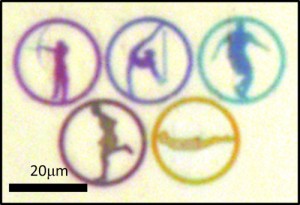 Color is all about the wavelength of light that comes off an object. A chemical, a pigment called anthocyanin is what makes an apple red. But sometimes an object doesn’t have a particular color because of pigment. You can also make something appear to have color using physical structures that are on the nanometer scale. If you have a bunch of ridges that are spaced out about 600 nanometers or so, then red light will be diffracted and the object will appear ‘red’. Peacocks and those blue morpho butterflies have color not because of pigments but because of tiny structures that diffract just certain wavelengths of light. The problem is that the color produced by these ridges is very particular about the angle that you view them at. Now scientists are making displays that show color but at less sensitive to the angle at which they are viewed. These new types of structures are less sensitive to the angle at which they are viewed. They hold promise for a new generation of displays that won’t involve pigments but just these tiny ridges.
Color is all about the wavelength of light that comes off an object. A chemical, a pigment called anthocyanin is what makes an apple red. But sometimes an object doesn’t have a particular color because of pigment. You can also make something appear to have color using physical structures that are on the nanometer scale. If you have a bunch of ridges that are spaced out about 600 nanometers or so, then red light will be diffracted and the object will appear ‘red’. Peacocks and those blue morpho butterflies have color not because of pigments but because of tiny structures that diffract just certain wavelengths of light. The problem is that the color produced by these ridges is very particular about the angle that you view them at. Now scientists are making displays that show color but at less sensitive to the angle at which they are viewed. These new types of structures are less sensitive to the angle at which they are viewed. They hold promise for a new generation of displays that won’t involve pigments but just these tiny ridges.
Read more
Sometimes the World’s Tiniest Isn’t the Best
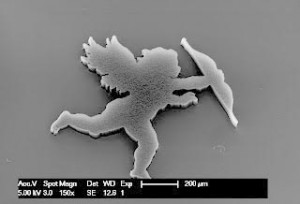 Tomorrow is Valentine’s day and just in time is the “world’s tiniest” cupid. Cupid is the little guy who flies around and shoots arrows into folks and makes them fall in love. Now scientists at Brigham Young University have made a tiny cupid out of carbon nanotubes. Just a few hundred nanometers across, cupid appears to have launched his nano arrow. Now the love of your life can be smitten by a nano-gesture of your affection. Best you also send flowers or a box of chocolate.
Tomorrow is Valentine’s day and just in time is the “world’s tiniest” cupid. Cupid is the little guy who flies around and shoots arrows into folks and makes them fall in love. Now scientists at Brigham Young University have made a tiny cupid out of carbon nanotubes. Just a few hundred nanometers across, cupid appears to have launched his nano arrow. Now the love of your life can be smitten by a nano-gesture of your affection. Best you also send flowers or a box of chocolate.
Magic Cotton
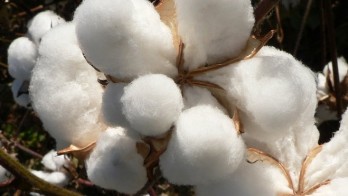 Cotton is one of those materials that everyone takes for granted. What’s nano about that? Scientists from Eindoven University (in the Netherlands) have treated cotton with a special polymer that makes the cotton magical. At room temperature the polymer-treated cotton will hold 340% of its weight in water. Water collected from mist and other places. Heat it up and releases the water, pure enough to drink (or water plants). What is great is that it can be used over and over again to gather water and then distribute it. Cotton is grown around the world and treating it with this magical polymer isn’t too high tech, meaning that it might be useful technology for developing countries to help produce clean water.
Cotton is one of those materials that everyone takes for granted. What’s nano about that? Scientists from Eindoven University (in the Netherlands) have treated cotton with a special polymer that makes the cotton magical. At room temperature the polymer-treated cotton will hold 340% of its weight in water. Water collected from mist and other places. Heat it up and releases the water, pure enough to drink (or water plants). What is great is that it can be used over and over again to gather water and then distribute it. Cotton is grown around the world and treating it with this magical polymer isn’t too high tech, meaning that it might be useful technology for developing countries to help produce clean water.

